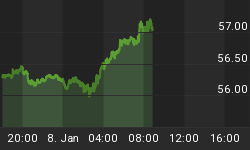The housing sector took another blow this week. Toll Brothers reported its preliminary results for the first quarter. While home building revenue increased 35%, new orders dropped 29% and the value of new contracts dropped 21%. This was the second time Toll Brothers shocked investors with lower than expected orders. Back in November, Toll Brothers announced that orders increased only 1% during the fourth quarter. The company reiterated what it said last time to account for the shortfall, namely the backlog in several communities was over one year and they wanted to let the backlog get worked off before selling anymore houses. It appears to have gotten worse during the quarter. In November the company said that 25% of its communities have backlogs extending 12 months or more. This week, it said that 43% of its communities have a backlog of 11 months or more. Home builders will be facing additional pressure this year as their costs continue to escalate. Louisiana-Pacific said that Oriented Strand Board (OSB) pricing was up 25% from last year and 15% from last quarter.
Last week, the Conference Board reported that consumer confidence in January reached the highest level since June 2002. Consumer confidence rose 2.5 points to 106.3. The strength was in the present situation, it rose 7.7 points to 128.4. This was the highest level since the September 2001 terrorist attacks. The expectations component actually fell 1.1 points to 91.5. Boosting the present situation was a 3.6 percentage point jump in jobs being plentiful along with a 2.2 percentage point drop in jobs being hard to get. Confidence in the Pacific region jumped 12.9 points to 126.4, the highest level since December 2000. The Mountain region jumped 29.2 to 143.6, highest since November 2000. The South Atlantic and Middle Atlantic were the only regions that consumer confidence fell in January.
Last week, retailers reported January sales results. By almost all accounts, retail sales were strong. According to First Call, retail sales increased 4.9% in January. This compares with analyst estimates of 4.1% and December's increase of 3.3%. Strength was broad based as 72% of retailers had sales growth higher than analysts' estimates. Teen retail was by far the best performing sector, up 15.5%, more than double the 7.2% growth that was expected. Department stores continued to lag, sales up 2.3% compared to estimates of 2.1%, but well ahead of last year's anemic 0.5%. We mentioned last week that Merrill Lynch reported that last month was the warmest January in 112 years. Retailer were also aggressive getting new merchandise right after Christmas so shoppers with wallets full of gift cards would have something fresh to buy. Having spring fashion in the store earlier combined with very warm weather January created very strong results. However, it is likely that sales were pulled from February and March. Retail sales have kept pace during the first week of February. According to the International Council of Shopping Centers, chain store sales increased 3.8% during the first week of February.
Retailers are the only major group left to report earnings. Given the strength of holiday sales and the follow through in January, earnings are likely to be strong. Earnings growth for the S&P 500 now stands at 13.8%. First quarter earnings pre-announcements are running slightly more negative, with 62% of the pre-announcements being negative. This compares to 57% last year and 60% last quarter.
Cisco Systems announced that its second quarter earnings increased 18% to $0.26 per share, one penny higher than analysts' estimates. Revenue growth was only 9.6% during the quarter, the slowest in two years. Investors embraced optimistic comments from John Chambers, Cisco's CEO. He said that revenue growth would accelerate to 10-12% for the quarter ending in March 2006. This was one of the positive signs in the technology sector that has been plagued by companies reported earning and guidance that was lower than was being predicted.
After several years of lackluster sales, Coca-Cola increased advertising spending by 12%. The result was volume growth of 4% and North America volume growth of 3%. This was the first time since in four quarters that volumes increased in North America. The increased spending caused operating margins to shrink by almost 300 basis points to 22.7%, the lowest operating margin in at least five years.
Church & Dwight added to the string of companies implementing higher prices to offset higher commodity prices. Higher commodity prices crimped gross margins by 350 basis points. The maker of Arm & Hammer and other personal care products announced that it increased prices by 4-10% on 35% of its products.
There is little doubt that the economy continued to expand in January. Even though most homebuilders are reporting lower orders, investors are focusing on other data points. The economy added 193,000 jobs in January. This was lower than the 250,000 economists expected, but similar to last month, December's gain was revised upward by about 30,000. Additionally, the unemployment rate dropped to 4.7%, which lowest since July 2001. This week, Alan Greenspan spoke to a group of Lehman Brothers clients and said that the economy was doing well and the Fed will have to raise rates to keep the economy from overheating. In the past, when housing faltered, rates fell which would cause housing to stabilize and rebound. This time, as housing as started to show signs of stress, rates have gone higher. In fact, fed funds futures are now pricing in an 80% probability of 5% fed funds by the June meeting.
















